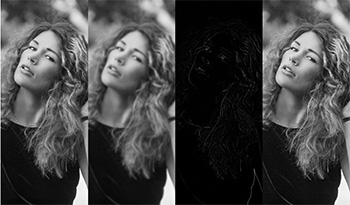Tip #1105: What is Sharpening?
… for Codecs & Media
Tip #1105: What is Sharpening?
Larry Jordan – LarryJordan.com
Sharpening means enhancing the contrast of edges in an image.


This article, written by Henry Guiness, first appeared in Photography.Tutsplus.com. This is a summary.
We have all heard the term “sharpening.” But what is it and how do we apply it? There are three main reasons to sharpen your image: to overcome blurring introduced by camera equipment, to draw attention to certain areas and to increase legibility.
Before I explain how to sharpen, we need to understand that sharpness is subjective.
Sharpness is a combination of two factors: resolution and acutance. Resolution is straightforward and not subjective. It’s just the size, in pixels, of the image file. All other factors equal, the higher the resolution of the image—the more pixels it has—the sharper it can be. Acutance is a little more complicated. It’s a subjective measure of the contrast at an edge. There’s no unit for acutance—you either think an edge has contrast or think it doesn’t. Edges that have more contrast appear to have a more defined edge to the human visual system.
Sharpening then, is a technique for increasing the apparent sharpness of an image. Once an image is captured, Photoshop can’t magically add more details: the actual resolution remains fixed. Yes, you can increase the file’s size but the algorithms any image editor uses to do so will decrease the sharpness of the details.
In the image in the screen shot, the author mimicked the Unsharp Mask effect in Photoshop. The first image is the original file, the second is a blurred copy, the third is the one subtracted from the other so as to detect the edges, and the fourth is the original image sharpened using the edge layer. Unsharp masking is the oldest sharpening technique. It subtracts a blurred (unsharp) copy from the original image to detect any edges. A mask is made with this edge detail. Contrast is then increased at the edges and the effect is applied to the original image. While unsharp masking was originally a film technique, it’s now the basis of digital sharpening.
The article continues with sharpening settings and illustrations of both good and bad sharpening, along with links to learn more.


Leave a Reply
Want to join the discussion?Feel free to contribute!